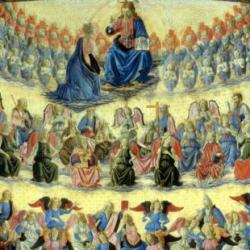The word “corporeal” is usually understood as referring to the physical body of a human being, especially as distinguished from the nonmaterial spirit of a human being. The word “incorporeal” is usually understood as nonphysical or nonmaterial. Thus, orthodox Christian theology asserts that God is incorporeal, meaning he does not consist of physical.
Before we go any further, we must answer the question, Who is God? I believe the God of the Bible, the God of Abraham, Isaac, and Jacob, is YHWH (perhaps pronounced and spelled “Yahweh”), and this God Jesus calls “Father.” According to the Bible and Jesus, Yahweh, the Father, is the one true God (e.g., Duet. 6.4-6; John 17.3).
But in orthodox Christian theology, which claims to be based on the Bible, the assertion that God is incorpreal is also understood as meaning that God does not have form, regardless of its nature. Advocates further buttress this argument by citing the Apostle Paul saying God is “invisible,… whom no one has ever seen or can see” (1 Timothy 1.17; 6.16 NRSV). But since Paul says this in a letter to his apostolic associate Timothy, I think he means only us human beings who are tainted with sin.
The primary biblical support for God being incorporeal is Jesus’ saying, “God is spirit, and those who worship him must worship him in spirit and truth” (John 4.24). But just because God is spirit does not necessarily require that he cannot have a spirit form that can be literally seen by others, such as angels.
In fact, the Bible describes angels as “spirits” while also providing many narratives in which human beings literally have seen angels. And when they have, these angels always have looked human.
Orthodox Christian theology also says God does not have form because he is spirit and his Spirit is everywhere. The chief biblical text cited for this viewpoint is Psalm 139.7-8: “Where can I go from your spirit? Or where can I flee from your presence? If I ascend to heaven, you are there; if I make my bed in Sheol, you are there.” King David wrote Psalm 139, and he begins it by saying, “O LORD, you have searched me and known me. You know when I sit down and when I rise up; you discern my thoughts from far away” (vv. 1-2). Why “far away” if God is everywhere? God is in heaven, and heaven is far away from earth. Since David says God knows David’s thoughts from far away in heaven, as if God is located only there, how can David also say in practically the same breath that God’s presence is also on earth?
I think we should conceive of God as being distinguishable in form and spirit. Thus, in his form God is located at a certain place, which is in heaven. He dwells there with his holy angels. That is why Jesus constantly said of God, especially according to Matthew, “Father in heaven.” At certain appointed times, God literally sits on a throne in heaven in which he judges. But at the same time God’s Spirit is everywhere. Thus, God himself is not everywhere but in heaven. That, I think, is the only way we can understand that at the eschaton, God is going to come here from heaven.
The Bible often relates that God sits on a throne in heaven. In a few instances, it provides narratives that describe something about God sitting on his throne there. In one instance, it vividly tells how he appears.
The Prophet Ezekiel had an experience in which he says “the heavens were opened, and I saw visions of God” (Ezekiel 1.1). Ezekile then narrates an entire biblical chapter describing what he saw in this vision. He first saw “something like four living creatures” who had “human form,” “four faces,” “four wings,” and “legs” (vv. 6-7) among other features. There also “was something like a dome shining like crystal, spread out above their heads” (v. 22). Then we read, “And above the dome over their heads there was something like a throne, in appareance like sapphire, and seated above the likeness of a throne was something that seemed like a human form…. This was the appearance of the likeness of the glory of the LORD” (vv. 26, 28). Many times Ezekiel uses the word “like” to describe what he saw. He obviously was describing the so-called spirit world where God dwells, that is, in heaven. So, Ezekiel describes God as having a “human form.” This famous Bible chapter sparked what is called “merkabah mysticism” among Jews. It is a focus on God seated on a chariot-throne that moves about with these four living creatures connected to it.
Likewise, Daniel had a vision in which he says, “As I watched, thrones were set in place, and an Ancient One [literally “Ancient of Days”] took his throne, his clothing was white as snow, and the hair of his head like pure wool; his throne was fiery flames, and its wheels were burning fire. A stream of fire issued and flowed our from his presence. A thousand thousands served him, and ten thousand times ten thousand stood attending him. The court sat in judgment” (Daniel 7.9-10). This is obviously a heavenly court scene. I believe the “thrones” set up included those of the twenty-four elders in heaven that we read about in the book of Revelation (Rev 4.4). They may comprise God’s heavenly court. So, Daniel describes the Ancient One, who certainly is God, as sitting down on a throne, being clothed, and having a head with hair. The implication is surely that God in this scene appears humanlike.
The book of Revelation repeatedly depicts God as seated on a throne in heaven. John the author describes visions he had. He says, “At once I was in the spirit, and there in heaven stood a throne, with one seated on the throne. And the one seated there looks like jasper and carnelian, and around the throne is a rainbow that looks like an emerald. Around the throne are twenty-four thrones, and seated on the thrones are twenty-four elders, dressed in white robes with golden crowns on their heads. Coming from the throne are flashes of lightning, and rumblings and peals of thunder,… Around the throne, and on each side of the throne, are four living creatures, full of eyes in front and behind” (Revelation 4.2-6).
Most Christian theologians and biblical exegetes through the centuries have asserted that we should not understand any of these portraits of God literally, that is, that God actually could be seen as having a human-like form with which he literally sits on a throne. But I do not think there is justification for this assertion and that they do this due to their preconceived view of God being spirit without form.
Then what about the Apostle Paul saying God is invisible? That is true of us fallen human beings, but not God’s angels. They literally see God all the time. For Jesus said, “angels continually see the face of my Father in heaven” (Matthew 18.11). And in the future, so will we humans who belong to God and his Christ. For in the beatitudes of Jesus’ Sermon on the Mount he said, “Blessed are the pure in heart, for they will see God” Matt. 5.8). And the book of Revelation says of the holy New Jerusalem that in the future comes “down out of heaven from God” that “the throne of God and of the Lamb will be in it, and his servants will worship him,” referring to God, and “they will see his face” (Rev 22.4).
In conclusion, I think the Bible verifies that God is incorpreal in the sense that he does not exist as physical being, yet he possesses a spirit form that angels and us resurrected human beings will literally see someday in the glorious future, when God and Jesus will literally dwell with their resurrected people.
















